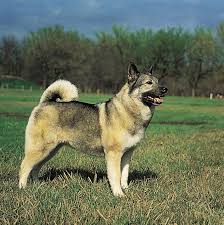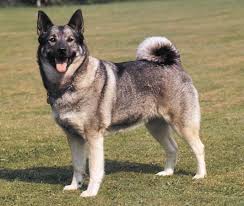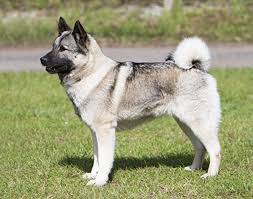The Norwegian Elkhound, also known as Norsk Elghund or Gray Elk Dog, is a breed of dog that originated in Norway. This ancient breed is known for its intelligence, loyalty, and bravery. They were originally bred to hunt big game, such as moose and bear, in the harsh Scandinavian terrain, and their versatility made them valuable to Norwegian hunters for centuries.
The Norwegian Elkhound is a medium-sized dog, weighing between 45 and 60 pounds, with a muscular build and a thick, weather-resistant coat that comes in shades of gray. Their almond-shaped eyes are dark brown and give the breed an alert and intelligent appearance. They have a wedge-shaped head with a broad, flat skull, and their ears are small, triangular, and set high on the head.
These dogs are highly energetic and require a lot of exercise, making them a great choice for active families. They thrive in cold weather and love to run, hike, and play outdoors. However, they are also adaptable and can live in warmer climates as long as they are provided with plenty of shade and water.
Norwegian Elkhounds are known for their independent nature, which can make training a challenge. However, with patience and consistency, they can be trained to obey commands and excel in obedience and agility competitions. They are also known for their strong prey drive and should be socialized early on to prevent them from chasing other animals.
One of the most distinctive traits of the Norwegian Elkhound is their bark, which is a high-pitched, piercing sound that can be heard for miles. This trait was essential in their hunting role, as it would alert their human counterparts to the presence of game.
Overall, the Norwegian Elkhound is a loyal and loving companion that makes an excellent family pet for those willing to provide them with the exercise and attention they need. Their history as hunters has made them an independent and self-sufficient breed, but they are also known for their affectionate and playful nature. If you’re looking for a dog that is both a devoted companion and a reliable watchdog, the Norwegian Elkhound may be the perfect choice for you.
Read Also: Processing and Marketing of Snails in Snail Business
History and Origin of the Norwegian Elkhound Dogs

The Norwegian Elkhound is an ancient breed that has been around for over a thousand years. It is believed to have originated in Norway, where it was used for hunting big game such as moose and bear in the harsh Scandinavian terrain.
The breed’s history can be traced back to the Viking Age, where it was highly valued for its versatility and ability to adapt to different hunting situations. They were also used as guard dogs, herd dogs, and even as companions for families.
The Norwegian Elkhound’s hunting skills were so highly prized that it was considered a symbol of Norway’s independence and freedom. The breed was featured in Norwegian folklore and literature, and it was also used as a mascot for the Norwegian resistance during World War II.
In the late 1800s, efforts were made to standardize the breed and establish a breed standard. The first Norwegian Elkhound club was founded in Norway in 1894, and the breed was recognized by the American Kennel Club in 1913.
Today, the Norwegian Elkhound is still used as a hunting dog in Norway, but it is also a popular family pet and show dog in many countries around the world. Despite its long and storied history, the breed remains relatively unknown outside of Norway and is considered a rare breed in some countries.
Norwegian Elkhound Dogs Health Issues and Lifespan

Like all breeds, the Norwegian Elkhound is prone to certain health issues. It’s important to be aware of these potential health problems so that you can provide your dog with proper care and monitoring throughout their life.
Hip dysplasia is one of the most common health issues in Norwegian Elkhounds. This condition occurs when the hip joint doesn’t form properly, which can lead to arthritis and lameness. Elbow dysplasia is another joint condition that can affect this breed.
Progressive retinal atrophy is a genetic eye disease that affects Norwegian Elkhounds, causing progressive vision loss that can eventually lead to blindness. Other eye conditions that can affect this breed include cataracts and glaucoma.
Hypothyroidism, a condition where the thyroid gland doesn’t produce enough hormones, can also affect Norwegian Elkhounds. Symptoms include weight gain, lethargy, and a dull coat.
Norwegian Elkhounds are also prone to developing ear infections, which can be caused by their long, floppy ears that trap moisture and bacteria.
The average lifespan of a Norwegian Elkhound is between 12 and 15 years, which is relatively long for a medium-sized dog. To help your dog live a long and healthy life, it’s important to provide them with regular exercise, a healthy diet, and routine veterinary care. Regular check-ups and early detection of any health issues can also help prolong your Norwegian Elkhound’s lifespan.
Read Also: Potential Food Safety Hazards and Control Measures
Norwegian Elkhound Dog Breed Complete Grooming and Care Guide

Grooming and care are important aspects of maintaining your Norwegian Elkhound’s health and appearance. Here is a complete guide to grooming and caring for your Norwegian Elkhound:
Coat Care: The Norwegian Elkhound has a thick, double coat that requires regular brushing to keep it in good condition. Brushing should be done at least once a week, and more often during shedding season.
Use a slicker brush and a metal comb to remove any loose or tangled hair. Bathing should be done as needed, but not too often, as frequent bathing can dry out the skin and coat. Use a gentle dog shampoo and be sure to rinse thoroughly.
Nail Care: Trim your Norwegian Elkhound’s nails regularly to prevent them from becoming too long and causing discomfort. Use a sharp nail clipper and be careful not to cut the quick, which is the pink part of the nail that contains blood vessels and nerves.
If you’re unsure how to trim your dog’s nails, consult your veterinarian or a professional groomer.
Ear Care: The Norwegian Elkhound’s ears should be checked regularly for signs of infection or irritation. Clean them with a gentle ear cleaner and cotton ball, being careful not to insert anything into the ear canal. If you notice any redness, swelling, or discharge, contact your veterinarian.
Dental Care: Good dental hygiene is important for your Norwegian Elkhound’s overall health. Brush your dog’s teeth regularly with a dog-specific toothbrush and toothpaste, or provide dental chews or toys to help keep their teeth clean.
Exercise: The Norwegian Elkhound is an active breed that requires regular exercise to stay healthy and happy. They love to run, hike, and play, and need at least 30 minutes of vigorous exercise per day.
Provide plenty of opportunities for outdoor activity, and be sure to supervise your dog when they are outside to prevent them from chasing other animals.
Training and Socialization: The Norwegian Elkhound is an independent breed that can be stubborn and difficult to train. However, early socialization and training can help to prevent problem behaviors and make your dog more obedient and well-behaved.
Positive reinforcement methods are recommended, and it’s important to be patient and consistent in your training efforts.
Health Care: Regular veterinary check-ups are important for maintaining your Norwegian Elkhound’s health. Your dog should receive annual vaccinations, as well as preventive treatments for heartworm, fleas, and ticks.
It’s also important to keep up-to-date on routine health screenings, such as blood tests and x-rays, as recommended by your veterinarian.
In summary, regular grooming, exercise, training, and veterinary care are all important aspects of caring for your Norwegian Elkhound. With proper care and attention, your Norwegian Elkhound can live a happy and healthy life as a beloved companion.
Read Also: Watershed Pollution Solutions and Management





